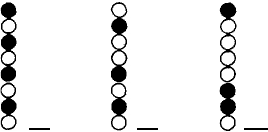
To fire any one pin, you send its number to the printer. To fire more
than one pin at the same time, add up the numbers of the pins and
send the total. Using these labels for the pins, you fire the top pin by
sending 128. To fire the bottom pin, you send 1. If you want to fire
only the top and bottom pins, you simply add 128 and 1, and send
129.
By adding the appropriate label numbers together, you can fire any
combination of pins. Below are three examples of how to calculate
the number that will fire a particular pattern of pins.
128
128
128
128 128
64
64
64
64
32
32
32
32
16
16
16
8
8
8
8
8
4
4
4
4
2
2
2
2
2
2
1
1
1
170 74
134
With this numbering system, any combination of the eight pins adds
up to a decimal number between 0 and 255, and no numbers are
duplicated.
Because there are 24 pins in each column, you must make a
calculation for each of the three sections in each column. As you can
see, this method of planning and printing dot graphics requires
considerable calculation. Because triple-density uses 180 columns
per inch, printing a single line of triple-density graphics only one
inch long requires 540 numbers. Fortunately, commercial graphics
software is available to do these calculations for you.
Before you can put these numbers into a graphics program,
however, you need to know the format of the graphics command.
4-10
Software and Graphics


















